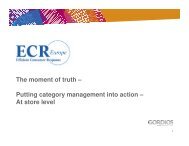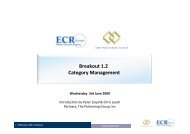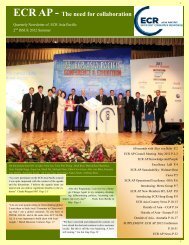You also want an ePaper? Increase the reach of your titles
YUMPU automatically turns print PDFs into web optimized ePapers that Google loves.
Figure 22: Some RTI design alternatives<br />
6.5. The Right Secondary RTI Design<br />
Although specific applications require specific features,<br />
typical design criteria are:<br />
• Suitable for both automated and manual<br />
handling, e.g. with handholds<br />
• Limited in proliferation, whilst not<br />
constraining development<br />
• Ease of identification, automatically and<br />
manually, in terms of the item itself, the owner<br />
and the RTI contents<br />
• Be durable<br />
RTI is appropriate in two different environments. The<br />
first is in dedicated retail operations, where it allows<br />
efficient shelf filling, eliminating the cost and handling<br />
associated with secondary packaging. In this type of<br />
dedicated system, the higher the turn rate of such RTI,<br />
the more the retail investment is justified. Retail-owned<br />
RTI used for fresh fruit and vegetables, for example,<br />
can generate a turn rate of 20 upwards.<br />
40<br />
Collapsible Nestable – Bale Arms<br />
Flat Tray<br />
Source: A.T. Kearney, Efficient Unit Loads project<br />
Nestable – 180˚ Stack<br />
Same Volume Empty and Full<br />
6.6. The Right RTI Management<br />
An appropriate management system for secondary and<br />
tertiary RTI has to ensure that RTI stocks are in the<br />
right place, quantity and condition, i.e. clean, at the<br />
right time. The management system covers forecasting,<br />
stock balancing, control, communication channels,<br />
hand-over, servicing and charging. Much of the intercompany<br />
communication required for (forecasting<br />
data, orders of empties, invoices, payment) should be<br />
electronic. Guidelines on the efficient use of Electronic<br />
Data Interchange (EDI) have been published by <strong>ECR</strong><br />
Europe in the ER and EDI Report.<br />
Depending on the particular application, management<br />
systems vary significantly. The main differences occur in<br />
the ownership of RTI and their penetration, leading to<br />
individual, bilateral and pool RTI systems. Management<br />
systems should focus on three aspects:<br />
• Harmonisation<br />
• Turn rate<br />
• Forecasting<br />
The Efficient Unit Loads Report










